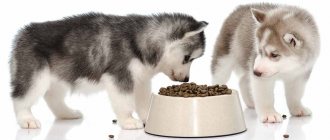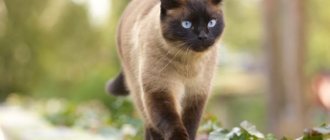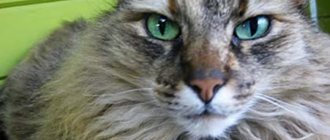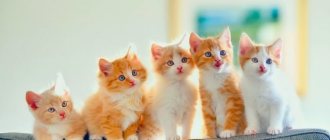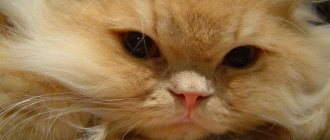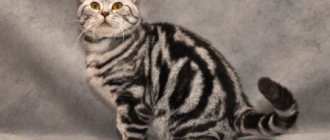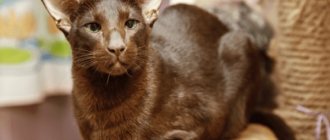If you are considering getting a kitten, consider the Bengal breed. Charming creatures that look like leopards will definitely appeal to all members of your family. They will not make you sad, but with their pranks and curiosity they will give you a great mood. Don't expect this creature to sleep on your lap all day long. This is an eternal source of energy. And, of course, they are distinguished by an amazing voice that will surprise even the most sophisticated listener.
Origin of the breed
Before moving directly to the diet, let's look at who Bengal kittens are. What to feed them will become clearer if we trace the path of formation of the breed. This is the result of crossing a wild leopard cat with other representatives. The result was a beautiful and strong animal. The ancestors had bright spots scattered on a yellowish background. They ate exclusively animal food. Bengal kittens are the same predators. We will consider in detail what to feed the spotted charmers further. However, it is already becoming clear that the basis will be meat and fish.
Baby care
Surely you have already visited the breeder and watched the touching little lumps that sleep next to their mother. And having had a good rest, they begin to play happily, which also causes a lot of delight. However, soon the future owners will bear the full burden of responsibility when Bengal kittens move into their home. What to feed funny babies so that they grow and develop properly, how to protect them from numerous diseases, all these issues can be further discussed with the breeder and veterinarian. Without harm to its own health, the cat will feed the babies only until they reach 1.5 months.
Before the baby arrives
One of the first fears of expectant mothers is toxoplasmosis. Believe it or not, expectant parents still surrender cats to shelters out of fear of contracting toxoplasmosis. This is completely unnecessary. Yes, cats can carry toxoplasmosis, and it can be spread to people by touching their feces and then ingesting the body, but it's pretty disgusting in the first place, so it should be pretty easy to avoid putting cat feces in your mouth, right? The easiest way to prevent toxoplasmosis is to wash your hands after cleaning the litter box. If this precaution is not enough, wearing rubber gloves when handling the litter box in any way, and then washing your hands when you remove the gloves will provide all the protection you need. Of course, it would be a very noble thing for the father-to-be to take on litter box duties as a symbolic way of protecting his child and helping the mother of his child through all stages of pregnancy and infancy.
The next important step before the baby arrives is to prepare the house for peaceful cohabitation between baby and cat. Bengal cats tend to be territorial. If the entire house was your Bengal cat's territory, then keeping your Bengal out of separate rooms as soon as the baby is born will end up doing more harm than good. What you want to do is provide a safe place for the cat in areas of the house where the child will spend a lot of time. Let's start with the children's room. Whether you realize it or not, you will be spending quite a lot of time at the changing table. If you haven't already chosen a changing table, we recommend that you purchase one with as much extra space as possible so that your cat can join in with all the activity that will take place there once she feels comfortable. This may not be possible, but it is absolutely necessary to have a shelf or cat station near the changing table so that the cat can observe the activity on the changing table from a safe place. You want your cat to have a safe place where she can watch the baby, but not get too close if it's not yet comfortable. Their relationship will last for years, so you want it to be good for both of them.
The next thing you need to think about when preparing your child's room is fragrances. People often worry that their cat will pee on their child's things. He will be marked incorrectly if he cannot make the appropriate mark. Often the room that becomes the nursery was open to the cat before it became the nursery, so the space is part of the cat's territory. If you suddenly take away this territory, the cat will have a hard time. You want the nursery to have items that belong to the cat that the cat can leave her scent on - places where the cat can sharpen her claws, rub her cheeks and lie down that will retain the cat's scent - which, by the way, we can't smell. . Bringing a small child into the home will be a significant change of territory for your cat, but you want the cat to feel that his territory is still safe - that it still belongs to him. The best way to do this is to prepare the baby's room in advance and give the cat enough time to leave its scent in the room by scratching and rubbing objects in the room long before the baby comes home.
You'll want to use the same concept in the family room or living room—wherever you think baby will spend the most time when not in the nursery. In this space - or in between - you need to make sure that there are two things: high places where the cat can avoid the grasp of the child's fingers, and plenty of scents so the cat can properly distribute its scent. Lay out as many baby items as possible—play mats, soft chairs, etc.—and open them so your Bengal can sleep before baby comes home. When you place the baby on these items, the baby's scent will merge with the cat's scent, making the baby more attractive to your cat.
Another step in preparing your cat for the baby is to prepare her for the noise of the baby. Find a crying baby soundtrack and play it while your cat eats his favorite food. If your cat stops eating, you've set the volume too high. Find a level where the cat will eat while you play the crying baby soundtrack. Increase the volume slightly with each feeding. Continue doing this until your cat eats her food through the baby's cries, which will be as loud as if you were giving birth to the baby in the same room. This causes your cat to associate the sounds of a baby crying with positive experiences rather than negative ones.
Finally, while you're preparing your bag of essentials to take to the hospital once labor begins, keep a pair of pajamas you slept in or a T-shirt you recently wore next to your hospital bag. Don't forget to leave an item of clothing with your scent on it for your cat while you are in the hospital. Remember that smell is the most important factor in determining a cat's safety in its territory. You are a normal part of his territory. If you'll be leaving a few days before you bring a new person onto the property, it's best to leave your cat as comfortable and safe as possible, which means leaving her in clothes covered in your scent to sleep. As you rush out the door to the hospital, leave this item of clothing in one of your cat's favorite sleeping spots.
Basics of feeding
The future owner must have a good idea of what responsibility falls on him. Therefore, choose a time and come watch how Bengal kittens play happily in their native nest. It is best to find out what to feed your future pet from the breeder. Proper and well-balanced nutrition early in a kitten's life lays the foundation for its future health. Depending on the age, the baby needs different nutrition, which should always contain only high-quality products.
First complementary foods
At about 3-4 weeks, Bengal kittens begin to receive food from a saucer. What to feed the baby at this age? Now you need to carefully give liquid or pasty food, which will not put a lot of stress on the body. If you have a small child, then by analogy you can understand what a kitten needs. Meat or semi-meat purees are ideal. From one and a half months, you can already add more solid foods, for example, minced meat with vegetables.
Starting from two months, you can start giving finely chopped raw meat. At the initial stage, be sure to give the tiny creature milk, cottage cheese, kefir and yogurt. The easiest way for kittens to switch from mother's milk to fermented milk products. This helps populate the microflora with beneficial microorganisms. Until about four months, they should be present in the diet daily. Closer to six months, it is already possible to transfer the kitten to a teenage diet, in which much attention is paid to meat components.
Phases of phasing
To the dismay of many new breeders, they soon discover that most Bengal kittens go through a stage of fuzzy camouflage - phasing. This is the stage their ancestors went through in the wild. They will begin this stage when they first start going outside and exploring their surroundings.
Their colors and fur patterns will be muted. This is genetically designed for their fur to hide the kittens from possible predators. You'll see this is most noticeable on their body and tail, where their hair is a little longer.
While kittens are still as adorable as all kittens are, this is the time in their lives when they really look the worst. This phasing stage usually occurs between 7 and 12 weeks of age.
phasing in bengal kittens
When you look at a Bengal kitten, the first hint of its true background color can be seen between the eyes and ears, and then on its forehead. As a Bengal kitten begins to mature, its coloring begins to appear on the shorter fur on its legs and then down its spine. Eventually, their colors will begin to spread throughout their body.
Check out these cute Bengal kittens in the video below:
These little furry creatures show you that even at a young age, Bengals show signs of their unique coat. However, as these kittens get older, their fur becomes more pronounced.
Feeding mode
It is very important not only to understand what you can feed your Bengal kitten, but how often you need to do it. You can be guided by the kitten's hungry look, but it is much better to immediately develop the optimal regime. A small pet should receive food 5-7 times a day. If he demands it more often, then at first you should meet him halfway, but gradually teach him to maintain limits:
- Up to 2 weeks of age, 10 feedings per day are required.
- A one-month-old kitten requires feeding at least 8-9 times a day.
- Before reaching two months of age, you need to organize feeding 7 times a day. Now your pet should sleep peacefully at night.
- Within a month, the number of feedings will be reduced to 6 times.
- Is your pet 4-5 months old? He can easily eat 5 times a day.
- By the 9th month of life, we reduce this amount to 4 times a day.
- By the age of one year, you gradually reach an adult diet, that is, the cat now needs to be fed twice a day.
Dimensions and weight by month
The Bengal cat is quite large: females weigh 4-5 kg, males - up to 9. Length from nose to tail - 90-100 cm, height - up to 40 cm. Males are visually larger than females.
| Age | Cat | Cat |
| newborn | 60 - 110 g | 65 - 130 gr |
| 1 month | 300 - 500 gr | 350 - 550 gr |
| 2 | 630 - 1100 gr | 740 - 1320 gr |
| 3 | 1.2 – 1.65 kg | 1.3 – 2.3 kg |
| 4 | 1.7 - 2.7 kg | 2.5 – 3.2 kg |
| 5 | 2.5 – 3 kg | 2.8 – 4.2 kg |
| 6 | 2.8 – 4 kg | 3 – 4.4 kg |
| 8 | 3.2 – 4.7 kg | 3.7 – 5.2 kg |
| 10 | 3.3 – 5.2 kg | 4.2 – 5.7 kg |
| 1 year | 3.4 – 5.3 kg | 4.6 – 6.4 kg |
| 2 years | 3.6 – 5.6 kg | 5.2- 8.5 kg |
This breed is not cheap. Kittens for the “soul” (i.e. with defects that cannot participate in exhibition events) cost between 15-30 thousand rubles. Breed class babies (with minor deviations) – 30-70 thousand. Show-class animals – over 70 thousand. When buying a kitten, go to a cattery with a good reputation. The kitten is taken when it is grown up (at least 12 weeks old), with documents (preferably the generation indicator is F4-F7), weighing at least a kilogram. He should already be accustomed to hands, contact and playful, with clean eyes, shiny fur and no runny nose.
What to feed a Bengal kitten (3 months)?
By this time, your pet has already started teething and can eat independently. His growth is very active, the skeleton is strengthened and the gastrointestinal tract is finally formed. The kitten's diet during this period should be as fortified as possible and especially rich in protein.
Approximately 60-80% of the diet comes from meat. It is correct to feed a Bengal kitten with boiled or well-frozen and scalded beef. Once or twice a week, boiled liver is included in the diet. Gradually begin to accustom him to porridges by mixing them with meat.
Eggs, or rather just the yolk, are very healthy for babies. Once a week it should be in the diet. Additionally, it is worth giving cottage cheese and yogurt.
How do little Bengals grow?
From a tiny lump grows a luxurious spotted short-haired animal with an affectionate domestic character. Sociable and intelligent cats quickly become attached to humans and require attention from the first day of their life. With proper care and nutrition, they grow quickly, turning into a luxurious animal. You can fall in love with this handsome spotted cat at first sight. Purebred Bengal cats respond to humans with love and devotion.
First month
A mini-leopard is born very tiny, weighing only 90-120 g. Sometimes very small kittens appear, viable individuals weigh more than 60 g. The weight largely depends on how many kittens are in the litter. They actively feed on colostrum and breast milk, build up immunity, and grow quickly. At 2 weeks the kitten will double its weight, and by the end of the fourth week it will weigh 400-700 g. If the pet is too thin, it will need additional attention.
After about ten days, hearing will appear, and after a few more days the kittens open their eyes. All these events will end by the end of the second week. Now the skeleton is strong enough, crawling and standing exercises begin. By the end of the third week, he can already sit and tries to walk carefully. A one-month-old Bengal's baby teeth appear and he begins to bite, scratch, and play. You can already determine the gender.
“When a newborn kitten is gaining too little weight, the diet of the nursing mother needs to be checked and adjusted.”
Second month
The kitten is strong enough to actively explore the world around him, plays a lot, runs around, but always returns to his mother - the source of food, warmth, and care. Particular entertainment is jumping from relatively high surfaces. It is necessary to limit access to potentially dangerous places, because the pet does not yet know how to correctly assess height. He is growing rapidly, at 2 months the weight reaches 1300-1500 g, mother's milk is no longer enough. It's time to introduce complementary foods and carry out deworming.
Third month
At 3 months, the kitten continues to develop; it has already completely switched to artificial nutrition. Time of first vaccinations. The color of the spotted coat, dark or white, naturally fades - this is phasing. The eyes are usually gray-blue, the color of the iris is formed. By the end of the month, the little Bengal already weighs about two kilograms.
He becomes even more active and restless. Security measures remain in effect. At this time, you need to communicate more with the kitten, educate it, because it is already ready to move to a new home. By this point, the pet should be accustomed to the tray.
“If the kitten is not gaining weight as rapidly after eight weeks as before, there is no need to worry. This is a normal change in growth dynamics for Bengals.”
Fourth month
The kitten becomes even more active, but remains not too careful. Security measures cannot be relaxed. The kitten is trained to use a scratching post. The color of the eyes changes, it has already formed, and phasing enters its final stage. If the move to a new house has taken place, the owner should constantly check the condition of the premises where the new family member lives.
Weight dynamics of Bengal kittens:
| Age | Approximate weight, g |
| In the first week | 70-120 |
| First month | 400-500 |
| 2-3 months | 500-2400 |
| 4-5 months | 2700-3600 |
| 5-6 months | 2900-3900 |
| 7 months | 4000 |
| 8-9 months | 4100-6000 |
| 10-12 months | 4200-6000 |
Narrow loopholes where the kitten can get stuck, wires, and other objects that can be chewed are unacceptable. Baby teeth are replaced by permanent teeth; for play, objects are needed that cannot be broken in order to partially swallow. Everything glassy, fragile, and breakable should be removed from the sphere of interests of a purebred pet. Puberty begins.
From five months to a year
From the time a kitten begins to change teeth, its immunity weakens somewhat. This continues for up to seven months. At about six months it is necessary to get a rabies vaccination if recommended by a veterinarian. After the cat appears in heat, you need to decide on her sterilization. This is a necessary measure for individuals not involved in breeding.
Males are castrated, if necessary, at seven or eight months, when they weigh four kilograms. It happens that a sexually mature kitten constantly yells, demanding a date with the cat. The problem needs to be resolved as early as possible to reduce stress for all residents of the house and for the Bengal itself.
By the end of seven months, the pet’s active growth is completed. He gains approximately 80% of his final weight, which will be gained at about two years of age and will be 6-8 kg. Female cats stop growing earlier than female cats, at about 5 months.
Feeding at 4-6 months
And we continue to talk about what is best to feed a Bengal kitten. At this age, they begin to grow very quickly and gain weight. Now you need to especially ensure that the foods in your diet are not stored as fat, but go towards building muscle mass.
Now the baby’s jaws have formed, and pieces of meat, beef or chicken offal can be given not ground, but cut into pieces. It is recommended to gradually add fermented baked milk or yogurt to your diet. It is advisable to consult a veterinarian about what to feed your Bengal kitten. 4 months is the period for the final formation of all organs and systems, so it is advisable for the doctor to regularly evaluate the baby’s development.
Nursery addresses
There are nurseries where you can buy a purebred, healthy and cute kitten with a pedigree.
We offer their addresses:
| Nursery | Address | Kitten price (RUB) |
| Kennel Big Bengal | Moscow, https://big-bengal ru/, Elena Rastorgueva | 25 000-50 000 |
| Bingora Bengal Cat Cattery | Moscow, https://www.bengora.ru/kotyata-na-prodaju html | from 25 000 |
| Kennel "Exotic Pride" | St. Petersburg, https://exoticpride ru/ Breeder Vladimir Ladygin | from 25 000 |
| Bengal cat nursery | Ukraine, Kyiv, https://www.bengalocats com/ | price not specified |
| Bengal cat nursery | Belarus, Minsk, https://bengal by/ | price not specified |
There are many nurseries, many offers, so you just have to choose a kitten.
Content recommendations
Bengals love to play and their hunting instincts manifest themselves during games. So take care of the objects that are dear to you and your hands. And don't limit their freedom.
If a cat does not give in to being held, there is no need to force it to do so. When walking, do not let your cat off the leash: her desire to be free is very strong, she will simply run away.
Try to organize proper nutrition. The cat's stomach is sensitive and it can get sick. Feed on time and introduce protein foods into your diet. Intestinal inflammation is possible.
The Bengal breed is not very susceptible to diseases, but still sometimes more so, like any living creature. If your pet has the slightest ailment, seek help from a veterinarian.
Buying a Bengal kitten will not be difficult: the nursery has completed the documents and received vaccinations. You will receive a healthy and strong kitten of the breed that you especially like. And a furry pet will appear at home.
Photos and names of cat breeds can be found in the article: cat breeds.
For information about caring for domestic cats, see the page.
Find out how to feed a kitten from this information.
Ready-made feed
Pet stores have a large number of offers. Everything is much simpler here, so we will not consider in detail what food to feed a Bengal kitten. But do not rely on advertising, it often provides false information. Only super-premium food is suitable for a Bengal cat. Their composition is balanced and has a full range of essential substances, including vitamins and minerals.
Be sure to follow the following rules:
- Do not mix professional food with your regular diet.
- Transfer your cat to another brand in stages.
Bengal cat standards
Genetics links the breed to the Asian leopard
The breed originates from the United States of America. A wild Bengal kitten rescued from poachers ended up in the hands of a breeder. Over the decades it has been crossed with various pets. Thus a new stable breed emerged. Since the late 90s she has taken part in various exhibitions.
Table 1. Bengal cat according to TICA
| Part of the body | Indicators |
| Weight | 4–8 kg |
| Body | Muscular, oblong, medium to large in size. The limbs are medium-long, the front pair is slightly shorter. The paws are clenched into round fists. The tail is also of medium length, quite thick, slightly tapering and rounded at the end. The skeleton is strong, devoid of subtlety. |
| Head | Wide wedge-shaped, rounded, the greater the difference with domestic breeds, the better. The jaw area is massive. |
| Ears | Small in height, wide at the bottom, rounded at the tips. The presence of tassels is not recommended. |
| Eyes | Oval, almost round, large, but not too big. Set wide and slightly oblique. The color of the iris is more welcome, and it does not depend on color (not counting links points). |
| Nose | Wide, large. The lobe is slightly upturned. The forehead meets the nose without a pronounced bend. The bridge of the nose is located just above the eye sockets. |
| Muzzle | Wide, the whisker pads stand out and have a slight pinch at the transition to the muzzle. The cheekbones are high and expressive. |
| Coat | The length of the hairs is short or medium, in kittens it is a little longer. It looks rich and shines (glitter effect), believed to be due to the voids in each fiber. The hairs lie tightly to the body. |
It is sometimes claimed that Bengal cats are hypoallergenic. But this is not entirely true. In fact, they simply shed less than many other breeds.
Less fur makes it easier for people to tolerate the presence of these cats in the house.
Bengal cat in all its glory
Color
The coat color of high-quality Bengals is contrasting and bright. The belly is lighter in color, with noticeable spots.
The final color is acquired only by 16 months. The photo shows a Bengal cat with a brown tabby kitten
The color of the head, typical of a tabby, is important. The eye sockets, the nasal mirror should be outlined, there should be a letter M on the forehead, and dark stripes on the cheeks. According to the standard, contrasting rings or rosettes are placed on the tail, and the limbs are “decorated” with bracelets. One of the most important requirements for coloring is the horizontal placement of spots and stripes, while usually it is vertical.
Absence of spots on the belly is considered a serious defect
The patterns characteristic of the breed are spots and stripes. The spots can be of any design - for example, bagels, but with clear edges. They must be formed by two or more colors. Marble colors, which are formed from intertwining color ribbons, are also recognized as standards.
There are two types of tabby colors recognized: brown and silver. But there are also snow bengals, which are divided into colorpoint, sepia, and mink. Blue cats are also considered standard; their fur is silver; the contrast here is somewhat less pronounced.
Bengal cat tabby color - silver
There should be a letter M on the forehead
Content Features
Adult cats do not cause their owner unnecessary trouble. All that is needed is timely vaccination and feeding, as well as the love of the owner. Be sure to install a scratching post in your apartment. From their ancestors, these creatures inherited long and sharp claws that need to be sharpened periodically. These are real athletes who cannot sit idle, so in a small apartment a frisky kitten can ruin all the curtains by swinging on them. It is much better if he has the opportunity to play outdoors and hunt birds.
But there is no need to wash and comb these cats. These are very clean creatures that carefully lick themselves, even if you lightly touch their fur, which is short and shiny. By the way, it has one feature - it changes color depending on the lighting. In the bright sun, the fur shines, shimmers and shines. These are very elegant cats that people like. They are very active and inquisitive.
Character and behavior
A wild cat, as they say, has a wild character. Their ancestors, who loved free life and independence, passed on their most striking character traits to their descendants, so the Bengal is a real bundle of energy. The bunch is wayward and capricious, but with the right upbringing it can become a completely friendly and balanced member of the family. Bengals need constant human attention and communication, otherwise they quickly run wild.
They are friends with dogs, live quietly side by side with cats of other breeds, but other pets, alas, will be under constant threat. Hunters by nature, Bengals will not rest until they catch all the fish from the aquarium, strangle the birds in the cage and get the hamster out of his house.
They love affection, but do not tolerate intrusion into the territory they consider theirs. They prefer fun games and running around the house to sitting on their hands. Very talkative: ready to “talk” to everyone who is nearby.
Does your cat like to swim?
Not really
Playfulness lasts until death, so you will have to equip your pet with nothing more or less - a play corner in the apartment, and a bigger one. And also: walk with your cat more often, giving her the opportunity to climb trees and explore the surroundings in as much detail as possible. Bengals get bored with toys quickly, so be prepared to spend money.
The Bengal is one of the most intelligent and savvy breeds, able to wait and adapt to circumstances. They quickly learn to open doors, turn lights on and off, turn the faucet handle, and even flush the toilet.
These little thieves love to hide small things that you carelessly left in plain sight. Keys, keychains, iridescent hairpins, paper bills - everything that rustles, shines and knocks immediately attracts their attention and is dragged away “in reserve.” By the way, they then prefer to tear up the papers, so hide the document first.
Bengals choose one leader for themselves, whom they will run from corner to corner like a dog. They get used to the leash and harness quickly. Children are treated with care and attention.
Bengal kittens are real little bullies, so teach them discipline from day one. Otherwise, an uncontrollable monster will grow out of a cute, restless fluffy.


